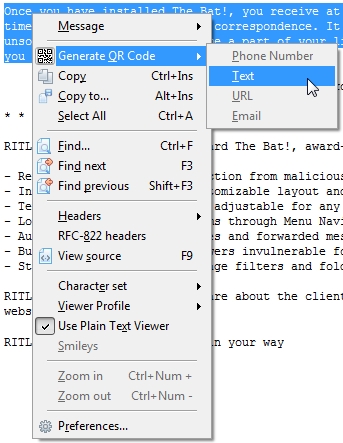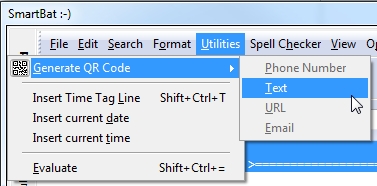The Bat! and QR code – How Does it Work?
The Bat! 5 is equipped with a new feature – QR code generator. A QR code is a type of matrix barcode developed by Denso Wave in 1994. QR stands for Quick Response, it was designed to allow its contents to be decoded at a high speed by scanning devices. The system has become popular due to its fast readability and comparatively large storage capacity. The technology has seen frequent use in Japan, and nowadays it's quickly spreading into Europe and North America. The code consists of black modules arranged in a square pattern on a white background. The information encoded can be made up of any kind of data – up to 7089 numbers, 4296 letters and numbers, 2953 bytes of binary code. Mobile device users can operate with QR codes, if their devices are equipped with special decoding software, allowing them to easily add contacts to the address book, read text notes, use URLs for browsing and so on.Starting with version 5, The Bat! can generate and send QR codes. Formats of QR codes can be: URLs, phone numbers, SMS, bookmarks, email addresses, email messages, business cards, geolocation data, WiFi access information and simple text without any attributes. If your mobile device has software that can receive and process these formats, the QR code will be decoded correspondingly.
The QR code generation form can be accessed in several ways. In some places of the program interface you can just select text, email address, URL, phone number etc., right click on it and open QR code generator that will create a code from the selected fragment.
The activation of this form is available on selecting text in the following places:
- Message Viewer Window:

- Message Editor Window:

- SmartBat Window, from the Utilities panel or by right-clicking:

- Address Book Window (right click the contact)

In their turn, attributes enable mobile devices to offer you certain actions for processing the decoded information. For example, if decoded information contains phone number attribute, the device lets you call this number, and if it contains URL attribute, the device offers you to access it through the browser. One portion of text can contain multiple attributes.
There are several software products for reading QR codes. Some of them recognize most attributes, some of them just give you decoded text. There are products with exotic features, like displaying decoded coordinates on a map, opening blogs or social networks. There are even products that use decoded information in order to create 3D models on top of the scanned code. Some Augmented Reality programs use QR codes as markers for virtual objects overlaid on real world images. In short, there are lots of options to use QR codes, depending on their attributes. Currently, we only use the most widespread attributes in The Bat!. In the future we are going to add the option of working with user templates for various services from the abovementioned and not only.
The QR code generator form has the following tabs:

- QR Code – Contains the generated image.
- QR Source – Shows the fragment used for generating the current QR code.
- URL – Allows for entering URL for generating its QR code.
- Text – Allows for entering text for generating its QR code.
- Phone – Allows for entering phone number for generating its QR code.
- SMS – Allows for entering information consisting of phone number and message text for generating QR code with SMS attribute.
- Bookmark – Allows for entering information consisting of URL and bookmark name text for generating QR code with bookmark attribute.
- Email – Enables entering email addresses for generating its QR code.
- Send Email – Allows for entering information consisting of email address, message subject and text for generating QR code with send email attribute.
- vCard – Allows for entering information consisting of first name, last name, email address, name of organization and website address for generating QR code with vCard attribute.
- meCard – Allows for entering information for generating QR code with meCard attribute.
- Geolocation – Allows for entering information consisting of location, latitude and longitude for generating QR code with geolocation attributes.
- WiFi access – Allows for entering information consisting of SSID, password and network type for generating QR code with information for WiFi access.
In the bottom part of each tab there is a QR code size indicator that prevents you from exceeding the limit for code generation. There are also buttons for various actions: Copy (copies the current QR code into clipboard), Save as (saves the current QR code into graphic file), Apply (generates QR code from the entered information) and Close (Closes the generator form).
When the QR code generator is accessed to process a selected piece of information, this fragment is placed in corresponding places. Thusly, the text will be inserted into Text, SMS, Send Email and meCard (as a note) tabs. URL – into URL, Bookmark, vCard (as website address) and meCard tabs. Email address – into Email, Send Email, vCard and meCard tabs. Phone number – into Phone, SMS, vCard and meCard tabs.
When the QR code is generated, you can scan it using your mobile device camera. You can also send it via email by copying and pasting it into a message or by saving and attaching it to a message. Once again, we draw your attention to the fact that QR codes are only decoded by mobile devices that are equipped with proper software and within the limits of software's functionality.